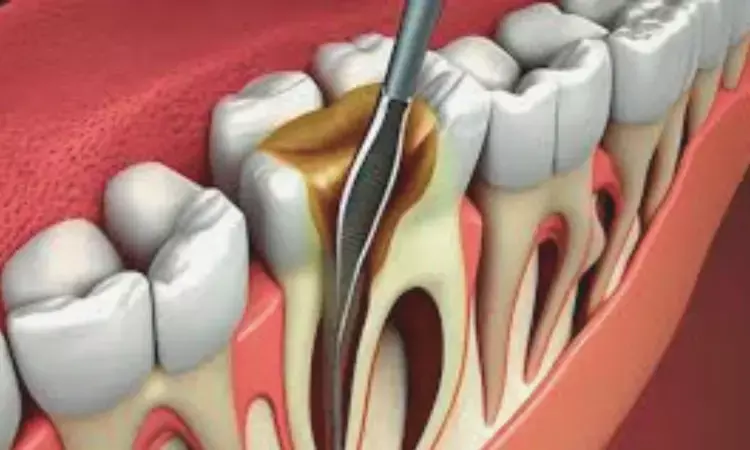- Home
- Medical news & Guidelines
- Anesthesiology
- Cardiology and CTVS
- Critical Care
- Dentistry
- Dermatology
- Diabetes and Endocrinology
- ENT
- Gastroenterology
- Medicine
- Nephrology
- Neurology
- Obstretics-Gynaecology
- Oncology
- Ophthalmology
- Orthopaedics
- Pediatrics-Neonatology
- Psychiatry
- Pulmonology
- Radiology
- Surgery
- Urology
- Laboratory Medicine
- Diet
- Nursing
- Paramedical
- Physiotherapy
- Health news
- Fact Check
- Bone Health Fact Check
- Brain Health Fact Check
- Cancer Related Fact Check
- Child Care Fact Check
- Dental and oral health fact check
- Diabetes and metabolic health fact check
- Diet and Nutrition Fact Check
- Eye and ENT Care Fact Check
- Fitness fact check
- Gut health fact check
- Heart health fact check
- Kidney health fact check
- Medical education fact check
- Men's health fact check
- Respiratory fact check
- Skin and hair care fact check
- Vaccine and Immunization fact check
- Women's health fact check
- AYUSH
- State News
- Andaman and Nicobar Islands
- Andhra Pradesh
- Arunachal Pradesh
- Assam
- Bihar
- Chandigarh
- Chattisgarh
- Dadra and Nagar Haveli
- Daman and Diu
- Delhi
- Goa
- Gujarat
- Haryana
- Himachal Pradesh
- Jammu & Kashmir
- Jharkhand
- Karnataka
- Kerala
- Ladakh
- Lakshadweep
- Madhya Pradesh
- Maharashtra
- Manipur
- Meghalaya
- Mizoram
- Nagaland
- Odisha
- Puducherry
- Punjab
- Rajasthan
- Sikkim
- Tamil Nadu
- Telangana
- Tripura
- Uttar Pradesh
- Uttrakhand
- West Bengal
- Medical Education
- Industry
Larger apical preparation sizes may Raise Post-operative Pain during root canal treatment, finds study

Egypt: Root canal treatment, a common dental procedure to relieve pain and save teeth from extraction, often involves various techniques to ensure effective cleaning and shaping of the root canal system. A recent triple-blinded split-mouth clinical trial has examined how different apical finishing sizes affect postoperative pain levels following root canal preparation.
The study, published in BMC Oral Health, revealed that larger apical preparation sizes during root canal treatments significantly raise postoperative pain.
Highlighting the impact of various apical preparation sizes on postoperative pain is crucial, especially when considering patients with identical pulpal histological statuses. Considering this, Mohammed Abou el Seoud, Department of Endodontics, Faculty of Dentistry, The British University of Egypt, Cairo, Egypt, and colleagues aimed to compare and evaluate the severity of postoperative pain following apical enlargement with two different sizes after the initial binding file (IBF) using the visual analog scale.
For this purpose, the researchers enrolled fifty “teeth” in 25 patients. They were assigned into two equal groups comprising 25 per group, using E3 Azure rotary files; In Group A, the mesial canals were prepared two sizes larger than the Initial Binding File, utilizing 35#/0.04 and 40#/0.04 for the distal canals. In Group B, the mesial canals were enlarged by three sizes compared to the IBF, using 40#/0.04, and the distal canals were prepared with 45#/0.04 files.
Patients were questioned on a modified VAS form to indicate the degree of their pain and assisted in telling their pain intensity during the following periods: 12, 24, and 72 h, and after a week.
The VAS data, analyzed as non-parametric, underwent the signed-rank test for between-group comparisons, Friedman’s test for within-group comparisons, and the Nemenyi post hoc test for further analysis.
The researchers reported the following findings:
- Regardless of measurement time, enlargement of apical preparation was significantly associated with higher pain scores.
- Within both groups, there was a significant reduction of measured pain score with time, with values measured after 12 and 24 h being significantly higher than values measured at other intervals and values measured after three days being significantly higher than the 1-week value.
"The findings showed that the size of the apical preparation significantly influenced postoperative pain outcomes. Differences observed across studies may stem from variations in patient pain perception and methodological approaches," the researchers wrote.
"Future research could investigate and compare postoperative pain among patients with symptomatic and asymptomatic irreversible pulpitis following root canal preparation using E3 Azure rotary instruments," they concluded.
The limitations of this study include the relatively small sample size and the use of IBF to determine apical enlargement size, despite Cone Beam Computed Tomography (CBCT) being recognized as a more reliable method for this purpose.
Reference:
Kataia, M.M., Kataia, E.M., Khalil, H.F. et al. Post-operative pain after root canal preparation with different apical finishing sizes a triple blinded split-mouth clinical trial. BMC Oral Health 24, 800 (2024). https://doi.org/10.1186/s12903-024-04527-9
Dr Kamal Kant Kohli-MBBS, DTCD- a chest specialist with more than 30 years of practice and a flair for writing clinical articles, Dr Kamal Kant Kohli joined Medical Dialogues as a Chief Editor of Medical News. Besides writing articles, as an editor, he proofreads and verifies all the medical content published on Medical Dialogues including those coming from journals, studies,medical conferences,guidelines etc. Email: drkohli@medicaldialogues.in. Contact no. 011-43720751


